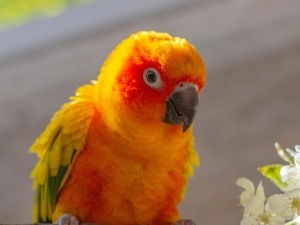
Conures are known to have a body of bright yellow feathers with green tips. They aren’t known to have black feathers on their body, so you’d understandably be surprised if your bird starts to develop black feathers.
This article is a look into why your conure feathers are turning black.
Table of Contents
Conure feathers turning black:
Birds are vastly different in appearance, some birds normally have black on their feathers and some birds don’t.
You’d understandably be worried if a bird that is not known to have black tips on its feathers starts to develop black tips on its feathers.
Here are reasons why your conure may be developing black tips on its feathers:
Wear and tear:
Your bird’s feathers get old, and the feathers will go through some wear and tear, and will show it.
The wear and tear can develop if your bird is biting its feathers, if the bird over preens its feathers, and if the bird rubs its feathers against objects regularly.
All of this friction on your bird’s feathers will inevitably result in some wear and tear and this will make the worn parts of the feathers look darker or even black.
It is unlikely that your bird’s whole feather will turn black from wear and tear, the tips of the feathers will however turn black.
What to do:
This is not an issue and is quite common so you don’t have to worry, and if this happens to your bird it does not mean that something is wrong with your bird, it is simply assign of used-up feathers.
The bird will molt the old feathers off and a new set of new feathers will grow.
You can help to ensure that the bird grows a set of new feathers that are as healthy and as vibrant as can be during the feather regrowth stage by giving the bird foods high in protein, which will build the feathers up, and high in fat, which will make the feathers shiny.
Vitamin A deficiency:
The condition of your bird’s feathers tells a story about the bird and sometimes this story is that the bird has a vitamin deficiency, a vitamin A deficiency to be exact.
This condition will not only cause your bird to develop black tips or black edges on its feathers but it can also cause your birds feathers to become dramatically lighter in color, can cause lethargy, affect eating habits and cause respiratory issues.
What to do:
The issue of a lack of vitamin A in your bird’s diet can be remedied by giving the bird more foods rich in vitamin A.
Foods that are rich in vitamin A include romaine lettuce, carrot, turnip greens, swiss chard, red sweet pepper, and collards.
Fungus:
Fungus can grow in a variety of locations including on your bird’s feathers.
If your bird gets pet a lot then the oils from the human hands can become a breeding ground for fungus.
What to do:
Taking the bird to the vet will be the best solution for this problem. The vet will put your bird under anesthesia before plucking any heavily soiled feathers off of your bird.
After that, your bird will need to be misted with a disinfectant until new feathers grow in.
If you enjoyed this article then you may also be interested in other bird related articles. Here are some articles that you may be interested in: Budgie Cere Hypertrophy, Budgie Cere Overgrowth, Why Is My Budgie’s Beak Dry?, How To Tell If Birds Are Bonded To Each Other, How To Know If A Parrot Is Angry, Why Are My Bird’s Feathers Turning Grey?, Cockatiel Growth On Side Of Beak, Black Feather Fungus, Black Spots On Cockatiel Feathers,

